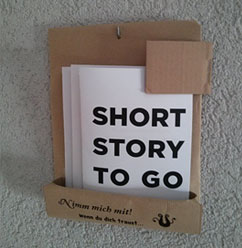The “Reworking Typography” series continues:
From time to time I find articles, texts or poems which I really like. But in some of those cases the text is typeset in such a poor way that it makes me sad. For me, typography has the same role as rhetoric—the way in which you say something can have a totally different impact and I think this is equally true for text and typography. Sometimes I take time and make an effort to typeset the text in a better way.
In the midst of 2014 I chose to newly typeset the fabulous short story “The Last Question” by Isaac Assimov. There are a lot of versions out there, but I haven’t been able to find a properly typeset one.
I chose to typset this specific story aſter I had read it and was thrilled by it. But sadly the typesetting of the document was horrible. However, it held a lot of potential: typesetting the computer speech or the different time zones for examples. I also liked the idea of using a grotesque font as a body text font, in order to support the futuristic manner of the story. I experimented with various layouts and fonts and at one point even had different, increasingly futuristic, fonts for the different time chapters. In the end, however, I decided to go for the less obtrusive approach.
I chose for a layout of DIN A5 with a two-column layout. I specifically chose the two-column layout, which I somehow associate with a more technical/scientific kind of text. The text was typeset using the PF Din Text Condensed. The computer output was set using OCR-A , a font which was designed as a mean to ease the transformation of printed text into a digital representation. For the ornaments I used the wonderful PTL Roletta Floral Ornaments font. The initials were typeset using two different fonts: the P22 Arts and Crafts and the Final Frontier font used in Star Trek. The titlepage was set using Gotham — a masculine, nearly monospaced, font designed by Tobias Frere-Jones for the GQ magazine. On the soſtware side this document was typeset using XeLaTeX. The (sadly very messy) sourcecode used to render the document is accessible via https://github.com/cmichi/reworking-typography.
The PDF is available here.
This is by far my favorite story of all those I have written.
After all, I undertook to tell several trillion years of human history in the space of a short story and I leave it to you as to how well I succeeded.
–Isaac Asimov on “The Last Question”
The Institute of Distributed Systems at the University Ulm runs the course “Practical IT-Secutiry” this semester. To me this was especially interesting because of the examination modalities: one does not have to take an exam, instead each student has to prepare and hold a lecture and accompanying assignments on a certain topic. I decided to dive deeper into Web Security and chose for Cross-Site Request Forgery (CSRF) attacks.
The presentation can be found online here. The preparation document for students was distributed one week in advance to the two-hour assignments (pdf). Assignments were based on the Metasploitable framework, the Damn Vulnerable Web App and TWiki. Additionally, I wrote some intentionally vulnerable PHP scripts with increasing levels of security.
All of this material (*.tex, *.html, *.pdf, etc.) and solutions for the assignments can be found in my talks GitHub repository as well.
The german weekly newspaper “DIE ZEIT” has an API available. This means it is easily possible for developers to use a lot of their data. Since they have made access to the data of nearly 400.000 articles since 1945 possible this is quite interesting (access to full texts is sadly missing, but a lot of other stuff is available). This post is about some of the interesting things I found whilst exploring the API.
My initial idea was to visualize how the ratio of articles with anglicisms evolved over time. At the moment this is too complex a project, due to the fact that getting the necessary data via the current API is difficult. However, I made some other interesting findings along the way.
The Wiktionary project provides a list of anglicisms (around 960 words) which I parsed out and used to search for articles concerning these words. This gave a list of how many matching articles on this word had been written each year since 1945. I also made an empty search to find out how many articles were created in total each year. These numbers could then be used to calculate the percentage of articles with anglicisms in each year.
Not all of the words provided interesting results but here is selection of some interesting ones. Please be aware that the statistics show a zoomed-in range. This is not a scale of 0-100%!
One should be very careful to interpret reasons for the peak just by looking at the visual representation. A potential reason might be the Gulf War in 1990–91 (the german translation is: “Golfkrieg”). Other causes worth investigating could be successes of german golf athletes or events around the VW Golf automobile.
Potential reasons for the peaks could be: in 1985 the Sinking of the Rainbow Warrior, in 1995 the Brent Spar protests and in 2010 the Deepwater Horizon.
The peak in 1987 could relate to the increased media coverage on aids. Also in 1987 the Institute for German Language (Gesellschaft für deutsche Sprache) chose “aids” has as the word of the year.
The peak in 1970 is most interesting to me, a potential cause could be the movement of 1968.
I have made the code used to gather the data and build the visualizations available under the MIT license via GitHub.











